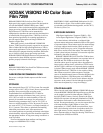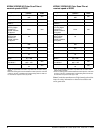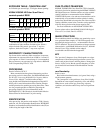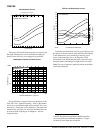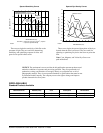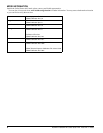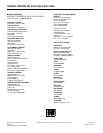
©Eastman Kodak Company, 2005
February 2005 • H-1-7299t
TECHNICAL DATA /
COLOR NEGATIVE FILM
KODAK VISION2 HD Color Scan
Film 7299
KODAK VISION2 HD Color Scan Film 7299 is a
high-speed color negative motion picture film designed for
use with the KODAK VISION2 HD System. When
transferred to video via telecine and used in conjunction with
image processing available in the KODAK VISION2 HD
Digital Processor, 7299 Film can be automatically
manipulated to reproduce the tone and color characteristics
of other Kodak color negative films. 7299 Film, itself, has
been optimized specifically for scanning applications to
provide superior light capture and image rendition for
transfer to digital data.
When used correctly in the KODAK VISION2 HD
System, 7299 Film can be properly exposed at an exposure
index of either 500 for high-speed applications or 320 for
lower-speed applications. It can also be exposed properly in
either daylight or tungsten shooting conditions without the
use of corrective filters. Image processing used in the
KODAK VISION2 HD Digital Processor will automatically
compensate for these different exposure conditions to
produce properly balanced video images.
BASE
KODAK VISION2 HD Color Scan Film 7299 has an acetate
safety base with rem-jet backing.
DARKROOM RECOMMENDATIONS
Do not use a safelight. Handle unprocessed film in total
darkness.
STORAGE
Store unexposed film at 13°C (55°F) or lower. For extended
storage, store at -18°C (0°F) or lower. Process exposed film
promptly. Store processed film according to the
recommendations in ANSI/PIMA IT9.11-1998: for
medium-term storage (minimum of ten years), store at
10°C(50°F) or lower at a relative humidity of 20 to 30
percent; for extended-term storage (for preservation of
material having permanent value), store at 2°C (35°F) or
lower at a relative humidity of 20 to 30 percent. For active
use, store at 25°C(77°F) or lower, at a relative humidity of
50 +/- 5 percent. This relates to optimized film handling
rather than preservation; static, dust-attraction and
curl-related problems are generally minimized at the higher
relative humidity. After usage, the film should be returned to
the appropriate medium- or long-term storage conditions as
soon as possible.
For more information about medium- and long-term
storage, see ANSI/PIMA IT9.11-1998,
SMPTE RP131-2002, and KODAK Publications No. H-1,
KODAK Motion Picture Film available online at http://
www.kodak.com/US/en/motion/support/h1, and No. H-23,
The Book of Film Care.
EXPOSURE INDEXES
High-Speed Application: Tungsten (3200 K) - 500
Lower-Speed Application: Tungsten (3200 K) - 320
Use these indexes with incident- or reflected-light
exposure meters and cameras marked for ISO or ASA speeds
or exposure indexes. These indexes apply for meter readings
of average subjects made from the camera position or for
readings made from a gray card of 18-percent reflectance
held close to and in front of the subject. For unusually light-
or dark-colored subjects, decrease or increase the exposure
indicated by the meter accordingly.
KODAK VISION2 HD Color Scan Film 7299 has been
designed for optimum performance at an exposure index of
both 500 and 320. EI500 can be chosen in low-light
situations where speed is required with no degradation in
image quality, shadow detail, or black level. EI320 can be
chosen if light is sufficient or if improved shadow rendition
is desired. When properly used with the KODAK VISION2
HD Digital Processor, 7299 Film is also capable of being
shot without correction in either tungsten or daylight
sources. It should be noted, however, that the designed color
balance of the film is 3200 K tungsten, and a KODAK
WRATTEN Filter No. 85 can be used to balance daylight
exposures on the camera if desired (though the exposure
index must be adjusted by
2
⁄
3
stops accordingly).
COLOR BALANCE
When correctly used in the KODAK VISION2 HD System
with the KODAK VISION2 HD Digital Processor, this film
can be properly exposed in either tungsten (3200 K) or
daylight (5500 K) sources. Natively, however, the film is
balanced for exposure with tungsten illumination (3200 K)
and filtration can be used for other illuminant sources if
desired. For tungsten shooting, you can also expose this film
with lamps that have slightly higher or lower color
temperatures (+/- 150 K) without correction filters, since
final color balancing can be done in telecine transfer. For
other light sources, use the correction filters in the table
below. Separate tables are listed for shooting 7299 Film at a
nominal speed of EI500 and EI320.



